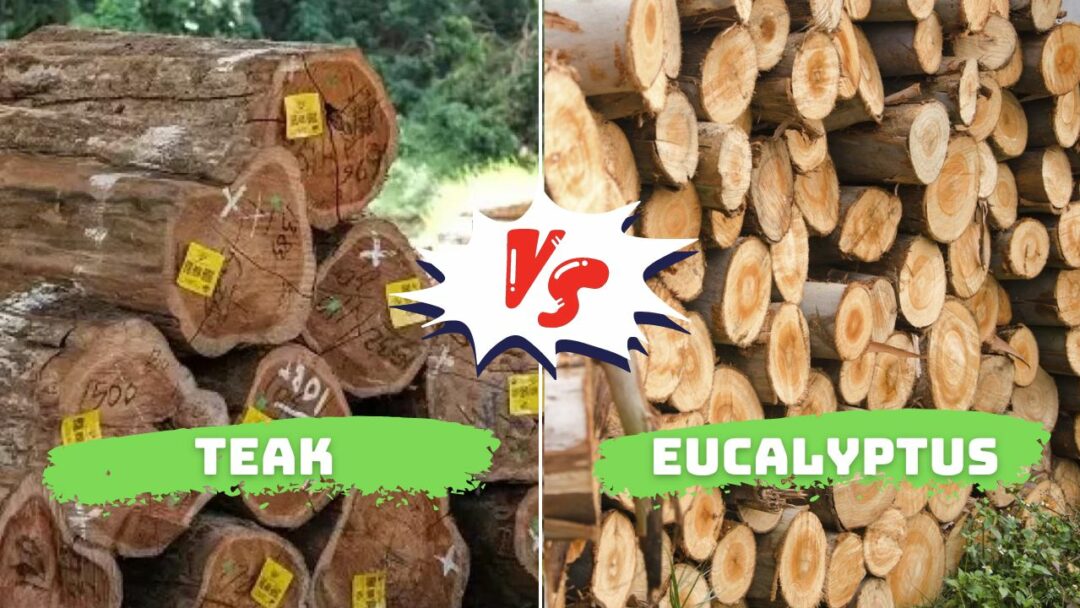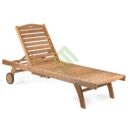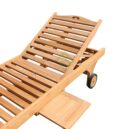Eucalyptus vs Teak Outdoor Furniture Pros and Cons of Each
When it comes to creating an inviting outdoor space, the choice of wood for your furniture matters. Enter the age-old debate: eucalyptus vs teak outdoor furniture. These two tropical hardwoods have graced patios, decks, and gardens for generations, each with its unique characteristics and allure.
Whether you’re looking for a luxurious, long-lasting piece or a more affordable alternative, understanding the differences between eucalyptus and teak outdoor furniture is crucial. From their unique characteristics to their maintenance requirements, we’ll explore what sets these two hardwoods apart in outdoor furniture.
Eucalyptus vs Teak Outdoor Furniture Pros and Cons of Each
Eucalyptus and teak are two tropical hardwoods that have gained immense popularity for outdoor furniture due to their resilience against harsh weather conditions and natural ability to develop a beautiful silver-gray patina over time. While they share some similarities, these woods also possess distinct characteristics that set them apart in cost and durability.

Teak, renowned as the “king of outdoor woods” has long been prized for its longevity and minimal maintenance requirements. Its dense grain and natural oils provide superior moisture resistance, making it an ideal choice for furniture pieces that will be exposed to the elements. On the other hand, eucalyptus, a fast-growing hardwood native to Australia, offers an attractive and more affordable alternative to teak, with a comparable aesthetic appeal.
Pros and Cons of Teak
Pros:
- Teak’s natural oils and tight grain contribute to its longevity.
- Minimal upkeep—no need for frequent sealing or treatments.
- Teak’s inherent oils make it water-resistant.
- Resists insects, rot, and decay.
- Teak’s beautiful grain enhances its appearance.
- Suitable for beach and poolside furniture.
Cons:
- Teak is considered the gold standard but comes with a higher cost.
- The quality justifies the price, but it may not fit every budget.
- Teak naturally weathers to a silver-gray patina.
- Some prefer this look, while others may miss the original honey brown color.
Pros and Cons of Eucalyptus
Pros:
- Eucalyptus overgrows, making it a sustainable choice.
- It’s more affordable than teak.
- Eucalyptus provides similar durability and resistance properties.
- Suitable for various furniture types.
- Eucalyptus is environmentally conscious due to its sustainable growth.
Cons:
- Eucalyptus needs regular sealing to maintain its appearance.
- Proper care is essential to prevent damage.
- Eucalyptus lacks the same natural oil content as teak.
- May not handle rain exposure as well.
Durability and Resilience: Teak’s Unmatched Longevity vs Eucalyptus’s Solid Performance
After all, your patio or deck furniture faces the elements—sun, rain, wind, and temperature fluctuations—day in and day out. Let’s explore how teak and eucalyptus stack up in the battle of longevity and resilience.
Teak’s Superior Durability
This tropical hardwood is renowned for its ability to withstand even the harshest weather elements, including intense sunlight, heavy rainfall, and extreme temperatures.
One of the key factors contributing to the teak’s superior durability is its high natural oil and rubber content. These properties act as a natural barrier, preventing moisture and protecting the wood from rotting, warping, or cracking over time. Even in consistently wet climates, teak furniture can maintain its structural integrity for decades with proper care.
Moreover, teak’s dense grain structure and natural oils make it highly resistant to insect invasion and deterioration caused by wood-boring pests. This quality ensures that your teak outdoor furniture remains free from unsightly damage and maintains its aesthetic appeal for years to come.
When it comes to the best outdoor furniture for direct sunlight exposure, teak is an excellent choice. Its natural resistance to UV rays helps prevent fading and discoloration, ensuring that your furniture retains its rich, warm hues even after prolonged exposure to the sun’s harsh rays.
Eucalyptus’s Solid Durability
While eucalyptus may not match teak’s unparalleled durability, it is still a solid and reliable choice for outdoor furniture.
It is essential to note that eucalyptus lacks the same level of natural oils and dense grain structure found in teak. As a result, it may be more susceptible to warping, cracking, and rotting if not properly maintained and protected from excessive moisture and humidity.
To ensure the longevity of eucalyptus outdoor furniture, it is crucial to invest in regular maintenance and treatment. This typically involves applying a water-based sealant or oil annually to protect the wood from the elements and prevent premature deterioration.
While eucalyptus may not be the best choice for direct sunlight exposure compared to teak, it can still perform admirably in shaded or partially shaded areas. With proper care and maintenance, eucalyptus furniture can provide a solid and attractive outdoor solution for those seeking a budget-friendly option.
Maintenance Requirements
The maintenance requirements can vary significantly between different wood types.
Teak’s Minimal Maintenance
One of the most appealing advantages of teak is its low maintenance requirements. This tropical hardwood is known for its natural resistance to the elements, making it a virtually hassle-free option for outdoor furniture.
Over time, teak naturally develops a beautiful silver-gray patina as a result of exposure to sunlight and weather. While some homeowners appreciate this weathered look, others may prefer to maintain the original honey-brown color. If you fall into the latter category, occasional sanding or power-washing is all that’s needed to restore the teak’s warm, rich tones.
Exploring how to treat teak outdoor furniture correctly is essential for preserving its natural beauty and longevity. Simple steps like cleaning with mild soap and water, and applying a teak sealer or oil every few years can go a long way in maintaining the wood’s stunning appearance.
Eucalyptus’s Care Needs
In contrast to teak’s low-maintenance nature, eucalyptus furniture requires more diligent care and attention to maintain its appearance and durability. Regular sealing with a water-based acrylic sealant is crucial for protecting eucalyptus from the elements and preventing premature deterioration.
Without proper treatment, eucalyptus may not handle exposure to rain and moisture as well as teak, leading to issues such as warping, cracking, or discoloration. Consistent application of a high-quality sealant helps to create a protective barrier, safeguarding the wood from the damaging effects of moisture.
It’s important to note that the maintenance effort required for eucalyptus is higher than that of teak. Homeowners should be prepared to commit to an annual sealing routine or risk compromising the furniture’s appearance and longevity.
While the maintenance requirements for eucalyptus may seem daunting, the trade-off is a more affordable option compared to the premium price tag associated with teak. For those willing to invest the time and effort into regular care, eucalyptus can still provide a beautiful and durable outdoor furniture solution.
Cost Considerations: Eucalyptus or Teak Outdoor Furniture – Which Is Right for You?
When it comes to outdoor furniture, cost is often a crucial factor that influences a buyer’s decision. Teak and eucalyptus present two distinct options with varying price points, catering to different budgets and priorities.
Teak’s Premium Price Tag
Teak is the most expensive wood type for outdoor furniture, and rightfully so. This premium material is renowned for its high-grade quality, unmatched durability, and timeless beauty. The high cost of teak furniture is a reflection of its superior properties and longevity.
While the initial investment in teak outdoor furniture may be substantial, it is essential to consider the long-term value it offers. With proper care and maintenance, teak furniture can last for decades, if not generations, making it a worthwhile investment for those seeking furniture that will stand the test of time.
Exploring teak outdoor furniture manufacturers Indonesia, one of the world’s leading sources of high-quality teak can provide access to authentic and sustainably sourced products, ensuring you get the most value for your investment.
Eucalyptus as an Affordable Alternative
For those who prioritize affordability without compromising on aesthetic appeal, eucalyptus presents an attractive alternative to teak. This hardwood offers a cost-effective solution for budget-conscious buyers seeking outdoor furniture.
While eucalyptus may not match the longevity of teak, it still provides a reliable option, especially when properly maintained. The lower price point of eucalyptus furniture allows homeowners to create inviting outdoor living spaces without breaking the bank.
It’s essential to weigh the trade-off between cost and durability when considering eucalyptus as an option. While it may require more diligent maintenance and potentially have a shorter lifespan compared to teak, eucalyptus furniture can still be a practical and attractive choice for those seeking a balance between affordability and quality.
Ultimately, the decision between teak and eucalyptus outdoor furniture comes down to individual preferences, budgets, and priorities. Teak remains the premium choice for those seeking unparalleled quality and longevity, while eucalyptus offers a more budget-friendly alternative for those willing to invest in regular maintenance. By carefully evaluating your needs, lifestyle, and financial considerations, you can make an informed decision that aligns with your desired balance of cost, durability, and aesthetic appeal.


